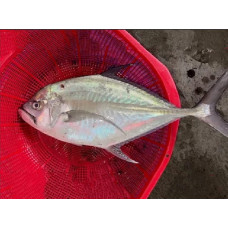Latin name
Ulua mentalis
Other name
Cale cale trevally and heavyjawed kingfish.
Identification
The body of the Longrakered Trevally is strongly compressed at the sides and covered with cycloid scales. The lower part of the thorax is scaleless to the pelvic fins; from the sides the bare area of the thorax extends diagonally to the bare base of the pectoral fins. The lower body profile is slightly less convex than the upper profile. The lower jaw protrudes forward, particularly in adults. The tip of the upper jaw is broad, extending to a vertical line passing through the anterior margin of the eye. The teeth on both jaws are small, villous, arranged in a narrow band. There are no teeth on the tongue. The first gill arch has 74-86 gill stamens, of which the upper part has 23-27 and the lower part 51-61. The gill stamens are very long, similar to feathers, and enter the oral cavity on the sides of the tongue. The lateral line forms a low, elongated arch in the anterior part and then continues straight to the caudal peduncle. The curved part changes into a straight line at the level of the vertical line between the 10th and 12th soft rays of the dorsal fin. The length of the chord of the curved part of the lateral line is almost equal to the length of the straight part, but may be slightly longer or shorter. The curved part has 55-63 scales; the straight part has 0-5 scales and 26-38 bony flaps. Vertebrae: 10 trunk vertebrae and 14 tail vertebrae.
Features of fish fins
It has two dorsal fins. The first dorsal fin has 8 hard rays and the second has 1 hard ray and 20-22 soft rays. The anal fin has 1 barbed ray and 17-18 soft rays, with 2 barbs in front of the fin. In juveniles, the anterior lobe of the second dorsal fin is enlarged (exceeding the length of the head); as it grows, its relative length decreases. In juveniles, the first rays of the second dorsal and anal fins are filamentous, their ends reaching the beginning of the caudal fin. The last soft rays of the dorsal and anal fins are not separated from the other rays. The pectoral fins are long and sickle-shaped. The caudal fin is crescent-shaped.
Fish colouring
The upper parts of the head and body are bluish-green, the lower parts are silvery. Large individuals have a faint dark spot on the upper edge of the gill cover (absent or weakly expressed in juveniles). Adults have a dark spot on the cheek. First dorsal and caudal fins dark to black; second dorsal and anal fins pale green except for dark anterior and distal edges. In small individuals, cheeks, lower jaw, inside of mouth and tongue are silvery. Juveniles have 7 or 8 dark stripes on the body.
Distribution
Widespread in the Indo-Pacific region from Tanzania to the Red Sea and Persian Gulf; further east along the coast of South and Southeast Asia to Indonesia and Papua New Guinea, including the Seychelles and Maldives; north to southern Japan; south to Australia. Long-tailed trevally found off Japan were all juveniles, suggesting that they were transported to these waters by the Kuroshio Current from the coasts of Taiwan and China.
Habitat
Marine pelagic fish that inhabit coastal reef areas at depths of 20-100m.
Size
The maximum length of these fishes is 100 cm, but they usually reach 60 cm.
Behavior
Adults inhabit shallow coastal waters close to reefs. Juveniles may enter estuaries.
Food and feeding habits
Juveniles feed mainly on small epibenthic crustaceans, while adults feed on crustaceans and fish.
Reproduction
They reach sexual maturity in the first year of life. Their eggs are pelagic.
Fishing
A commercially important species.
Relationship with a person
Harmless.
| Classification | |
| Phylum | Chordata |
| Class | Actinopterygii |
| Squad | Carangiformes |
| Family | Carangidae |
| Genus | Ulua |
| Species | U. mentalis |
| Features | |
| Conservation status | Least Concern |
| Habitat | Pelagic |
| Life span, years | No information |
| Maximum body weight, kg | No information |
| Maximum length, cm | 100 |
| Sailing speed, m/s | No information |
| Threat to people | Edible |
| Way of eating | Predator |
Longrakered trevally
Tags: longrakered trevally

